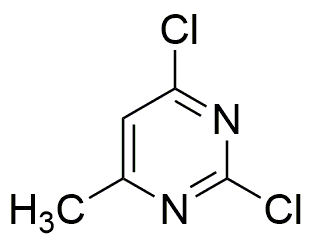2,4-Dichloro-6-methylpyrimidine is widely utilized in research focused on:
- Agricultural Chemistry: This compound serves as a key intermediate in the synthesis of herbicides, helping to control unwanted plant growth effectively. Its selective action minimizes damage to crops, making it valuable for sustainable farming practices.
- Pharmaceutical Development: It is used in the synthesis of various pharmaceuticals, particularly those targeting viral infections and cancer. Researchers appreciate its ability to enhance the efficacy of drug formulations.
- Material Science: The compound is employed in developing specialty polymers and coatings, offering improved durability and resistance to environmental factors, which is crucial for industrial applications.
- Analytical Chemistry: It acts as a reference standard in analytical methods, aiding in the detection and quantification of similar compounds in complex mixtures, which is essential for quality control in laboratories.
- Biochemistry: Researchers utilize it in studying enzyme inhibition and metabolic pathways, providing insights into biochemical processes that can lead to innovative therapeutic strategies.
General Information
Properties
Safety and Regulations
Applications
2,4-Dichloro-6-methylpyrimidine is widely utilized in research focused on:
- Agricultural Chemistry: This compound serves as a key intermediate in the synthesis of herbicides, helping to control unwanted plant growth effectively. Its selective action minimizes damage to crops, making it valuable for sustainable farming practices.
- Pharmaceutical Development: It is used in the synthesis of various pharmaceuticals, particularly those targeting viral infections and cancer. Researchers appreciate its ability to enhance the efficacy of drug formulations.
- Material Science: The compound is employed in developing specialty polymers and coatings, offering improved durability and resistance to environmental factors, which is crucial for industrial applications.
- Analytical Chemistry: It acts as a reference standard in analytical methods, aiding in the detection and quantification of similar compounds in complex mixtures, which is essential for quality control in laboratories.
- Biochemistry: Researchers utilize it in studying enzyme inhibition and metabolic pathways, providing insights into biochemical processes that can lead to innovative therapeutic strategies.
Documents
Safety Data Sheets (SDS)
The SDS provides comprehensive safety information on handling, storage, and disposal of the product.
Product Specification (PS)
The PS provides a comprehensive breakdown of the product’s properties, including chemical composition, physical state, purity, and storage requirements. It also details acceptable quality ranges and the product's intended applications.
Certificates of Analysis (COA)
Search for Certificates of Analysis (COA) by entering the products Lot Number. Lot and Batch Numbers can be found on a product’s label following the words ‘Lot’ or ‘Batch’.
*Catalog Number
*Lot Number
Certificates Of Origin (COO)
This COO confirms the country where the product was manufactured, and also details the materials and components used in it and whether it is derived from natural, synthetic, or other specific sources. This certificate may be required for customs, trade, and regulatory compliance.
*Catalog Number
*Lot Number
Safety Data Sheets (SDS)
The SDS provides comprehensive safety information on handling, storage, and disposal of the product.
DownloadProduct Specification (PS)
The PS provides a comprehensive breakdown of the product’s properties, including chemical composition, physical state, purity, and storage requirements. It also details acceptable quality ranges and the product's intended applications.
DownloadCertificates of Analysis (COA)
Search for Certificates of Analysis (COA) by entering the products Lot Number. Lot and Batch Numbers can be found on a product’s label following the words ‘Lot’ or ‘Batch’.
*Catalog Number
*Lot Number
Certificates Of Origin (COO)
This COO confirms the country where the product was manufactured, and also details the materials and components used in it and whether it is derived from natural, synthetic, or other specific sources. This certificate may be required for customs, trade, and regulatory compliance.


